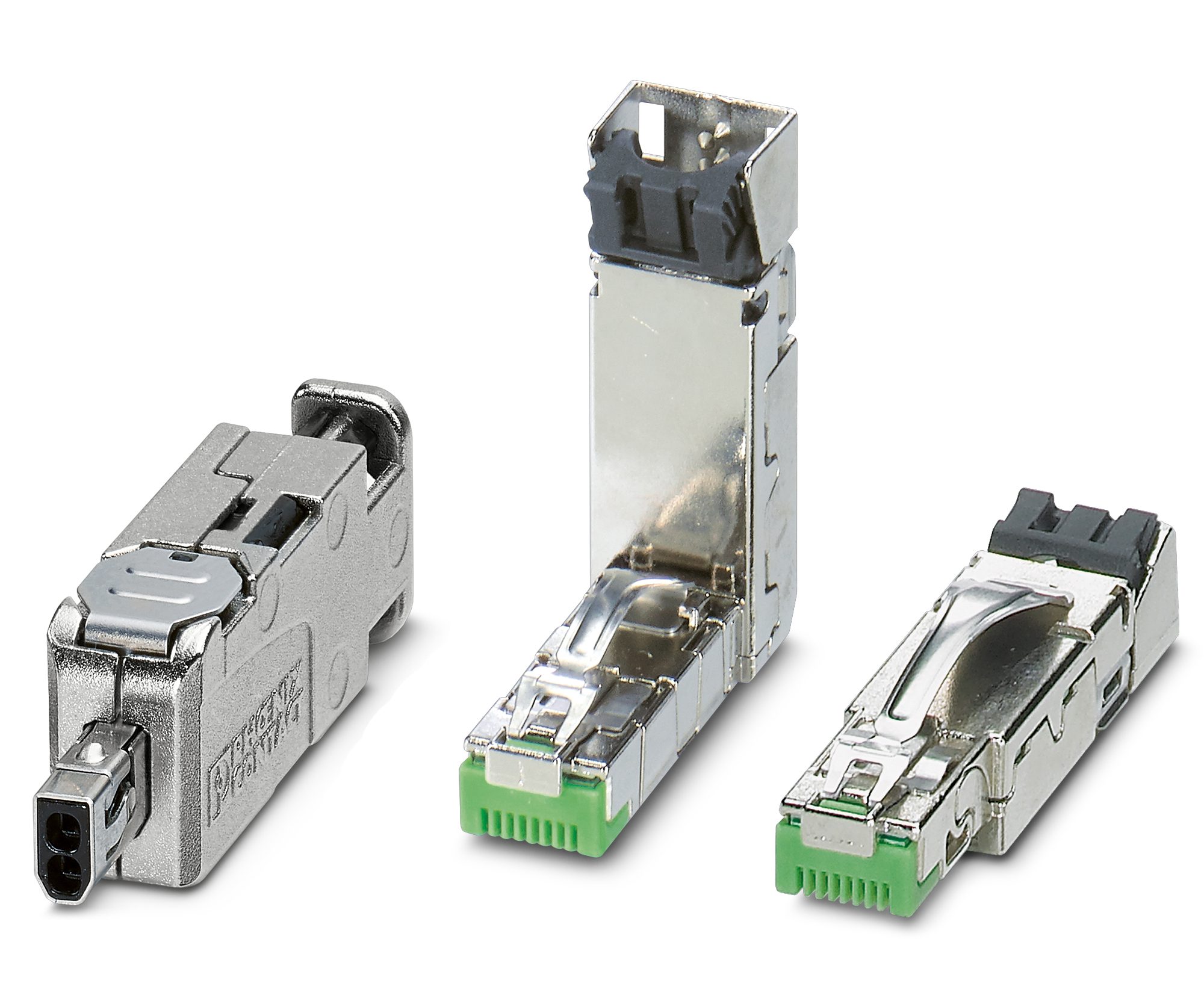Connect, Network, Evolve: The Intersection Between Reliability and High-Speed Industrial Communications
Real-time communication in industrial processes allows for process optimization and reduction in downtime. It requires reliable connector and cabling solutions that meet the demands of industrial environments while enabling high-speed data transmission and supporting various industrial communications protocols.
The evolution of industrial communications has increased the need for intelligence built into field devices, so these devices can collect, compute, and share information in real time. When we look at smart factory field devices, communications may take place at different levels, including inside the device and to and from other devices. Traditionally, a field device would collect data about an industrial task and send it out to a controller (PLC) for processing. Once the information was processed, the control device would decide the next steps and communicate with higher-level devices and/or the field device in question. In the case of smart devices, however, the measurement, computation, and decision-making stages may happen within the device itself before the information flows to the higher levels. This makes internal communications an integral part of a smart device ecosystem, along with external communications to and from the device.
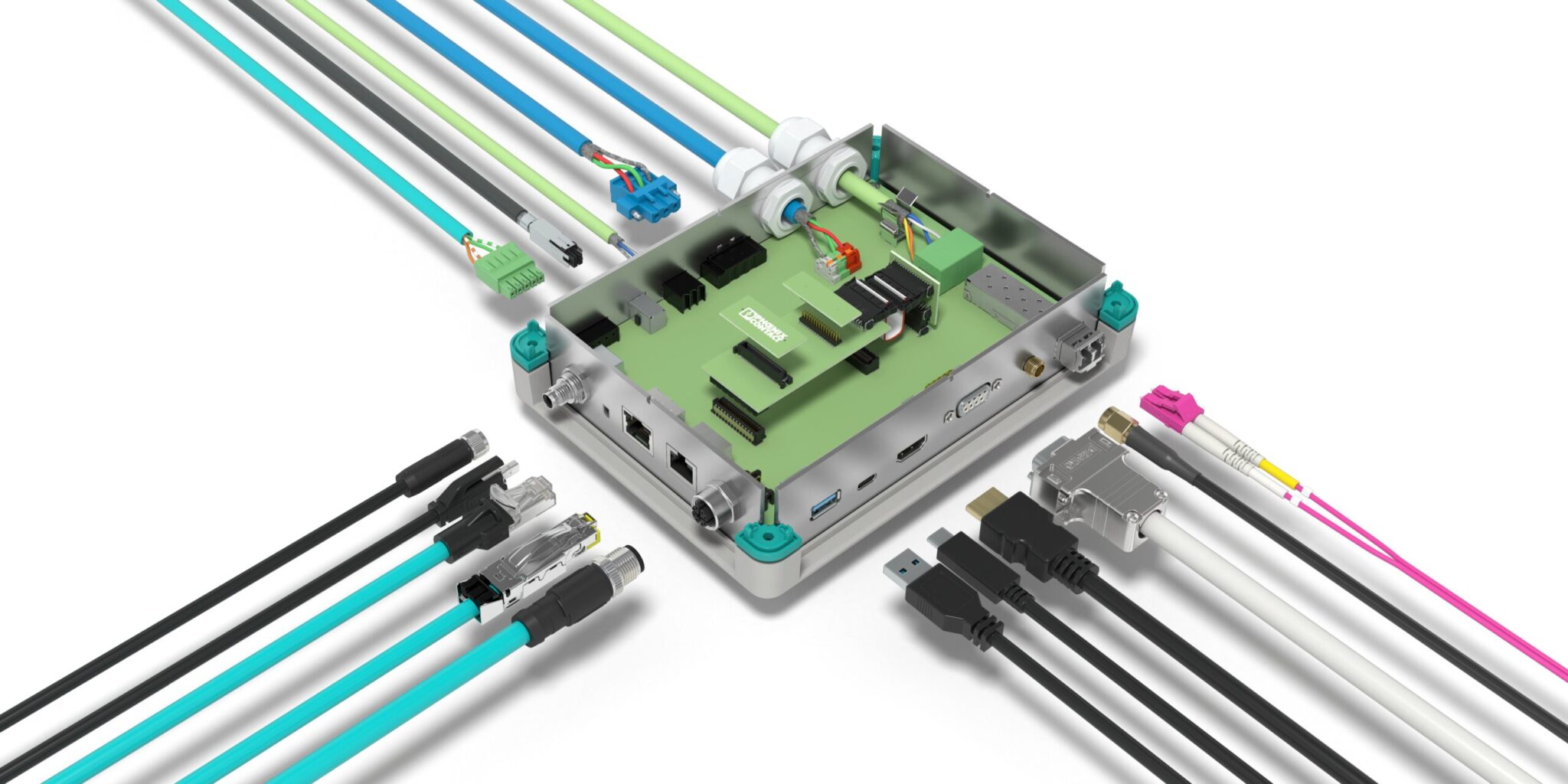
Device enclosure with connectivity options
The inside of smart electronic devices often requires internal boards that enable computing functionality within the device. Components such as microcontrollers, sensor modules, power modules, and communication modules enable sensing, data processing, and powering inside the device. They may require inter-board communications, which are enabled with the use of board-to-board connectors. These connectors are required to have optimal electromagnetic compatibility (EMC) properties and excellent signal integrity at high frequencies, while withstanding the characteristics of a harsh environment. The collected information is then transferred to other devices using robust interface connectors and cabling that transport the data from the field device to computers, switches, etc., with minor signal attenuation. At the same time, the field device must be able to withstand mating and unmating in an industrial setting.
When designing a smart field device for industrial applications, the designer should consider high-speed signal integrity and connector reliability, along with spacing requirements, ease of installation, and connector robustness.
Connectivity inside the device
As the need for built-in intelligence increases for field devices, so does the number of components required to enable communication, computing, measuring or sensing, and power. The need for devices that can be easily adapted or extended to different scenarios, such as different measurements or the option for wired and wireless communications, has led to a modular approach with separate PCBs to handle different functionalities.
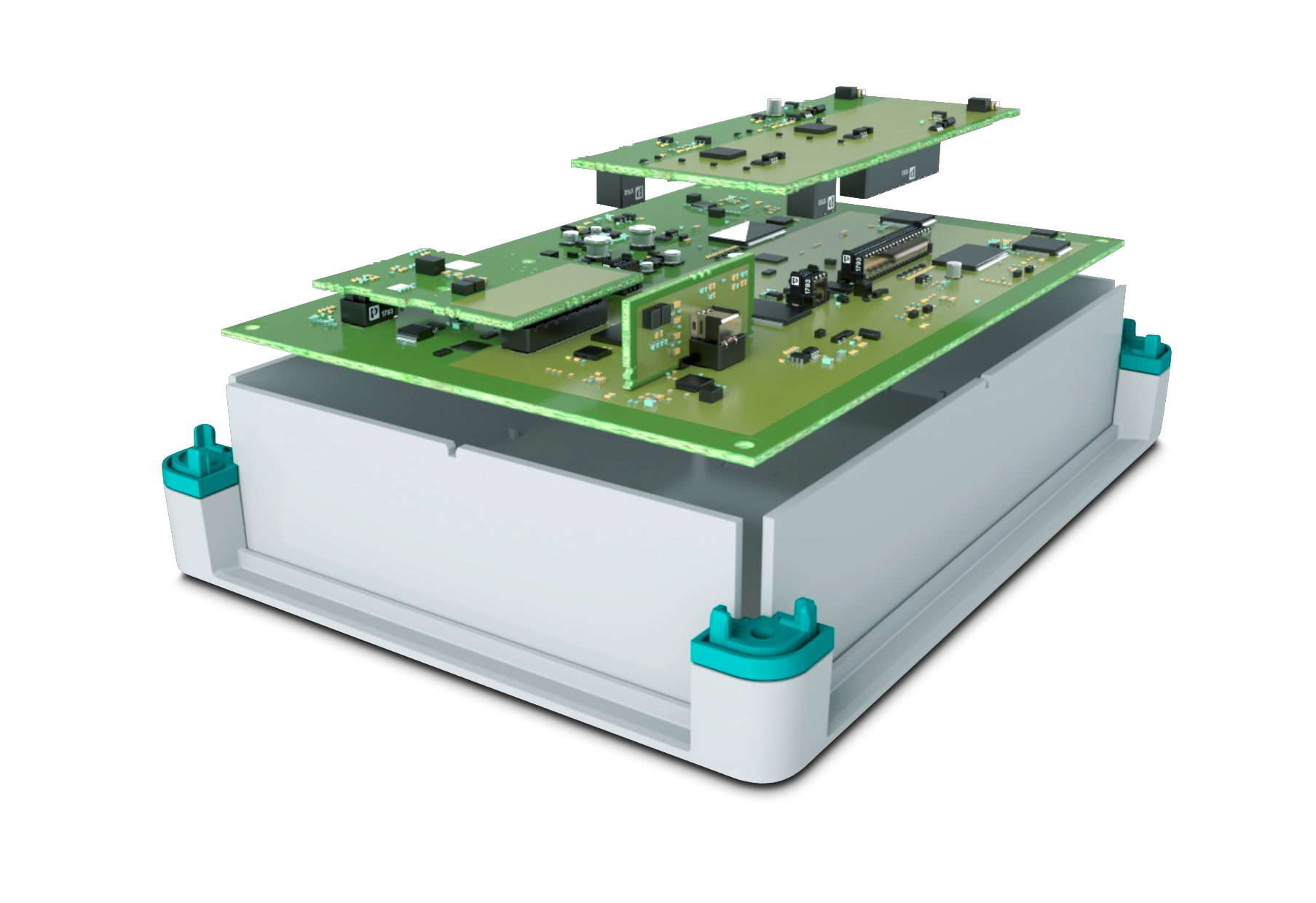
PCBs in various orientations
When incorporating multiple boards within a modular device, board configuration and component spacing can affect device size. Newer board-to-board connector solutions can address the need for modularity while minimizing device footprint and allowing for PCB stacking in different configurations (such as mezzanine, coplanar, or orthogonal). Industrial field devices require robust connector solutions that can withstand the field’s demanding, harsh conditions while supporting signal and high-speed data transmission.
Real-time data transmission requires connector solutions optimized for high-speed data transfer at high frequencies. This is often achieved with the use of differential pairs, although some applications can use single-ended lines. Regardless of the transmission method, the connector solution must be optimized for minimum attenuation (signal loss) at high frequencies and minimum crosstalk to and from adjacent lines. They also must be optimized for impedance environments of either 100Ω for a differential-pair line or 50Ω for a single-ended data line. Additionally, the connector solution must have some degree of EMC to avoid electromagnetic interference (EMI) onto adjacent components and to protect the high-speed signal from EMI radiators within the device ecosystem.
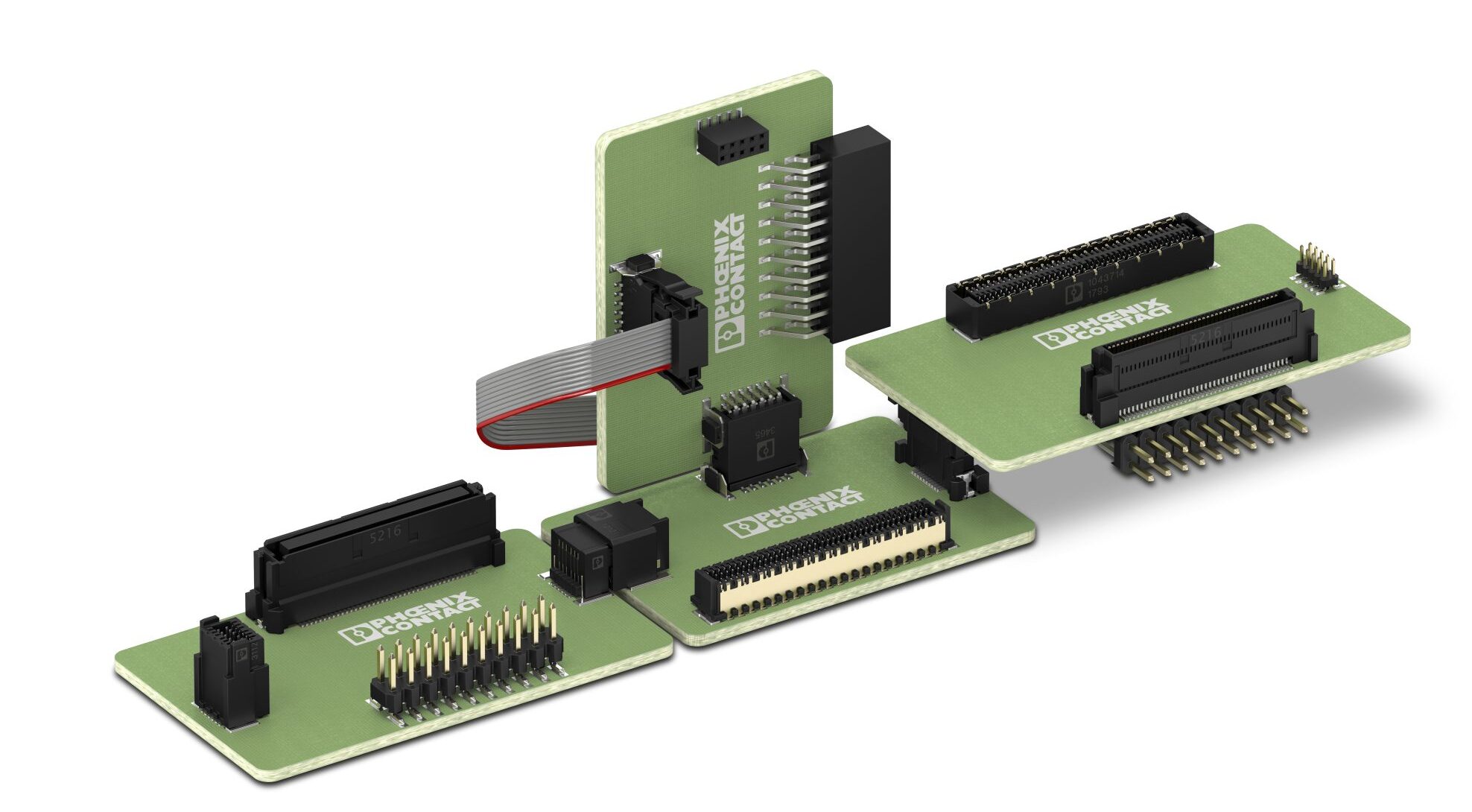
Phoenix Contact’s new FINEPITCH series is a suite of board-to-board and wire-to-board products specifically designed for industrial-grade applications.
Today’s board-to-board products can include cost- and space-optimized, shielded, and unshielded header and socket connectors for high-frequency transmission. This ensures maximum flexibility when designing and configuring board placement within a device. An example product is FP 0.8, a patented solution with bifurcated (dual) contacts with a 0.8 mm pitch that can withstand shock and vibration while enabling speeds of 16 Gb/s and higher at frequencies up to 8 GHz, depending on contact layout and board stack height. Additionally, the FP 0.8 connectors offer EMC shielding to protect against EMI. They also feature a housing geometry with tolerance compensation that allows for a longitudinal and transverse deviation of ±0.3 mm and an inclination deviation of ±5 degrees.
Connectivity at the device interface
As smart field devices collect and process data from industrial processes, the data is moved upstream in the process, to either the control level or to other field devices that need the information to make decisions about the process. In today’s world, devices connected to the internet can also stream data directly to the cloud, where the information can be accessible to other smart devices connected to the network.
Wireless communication is the preferred method of data transfer in commercial installations. However, industrial environments, such as industrial floors and automation islands, are susceptible to signal noise and interference. This can come from high-stress conditions like mechanical shock and vibration, moisture, climate conditions, and electromagnetic interference. Wireless data transfer in industrial environments is not as efficient as wired communications, so the preferred method of data transfer in industrial environments continues to be wired communication, often enabled using panel-mount standard interfaces. Standardization is important when selecting a solution for data transfer, as the chosen connector may need to be compatible with existing cabling infrastructure or support industrial protocols for data transmission.
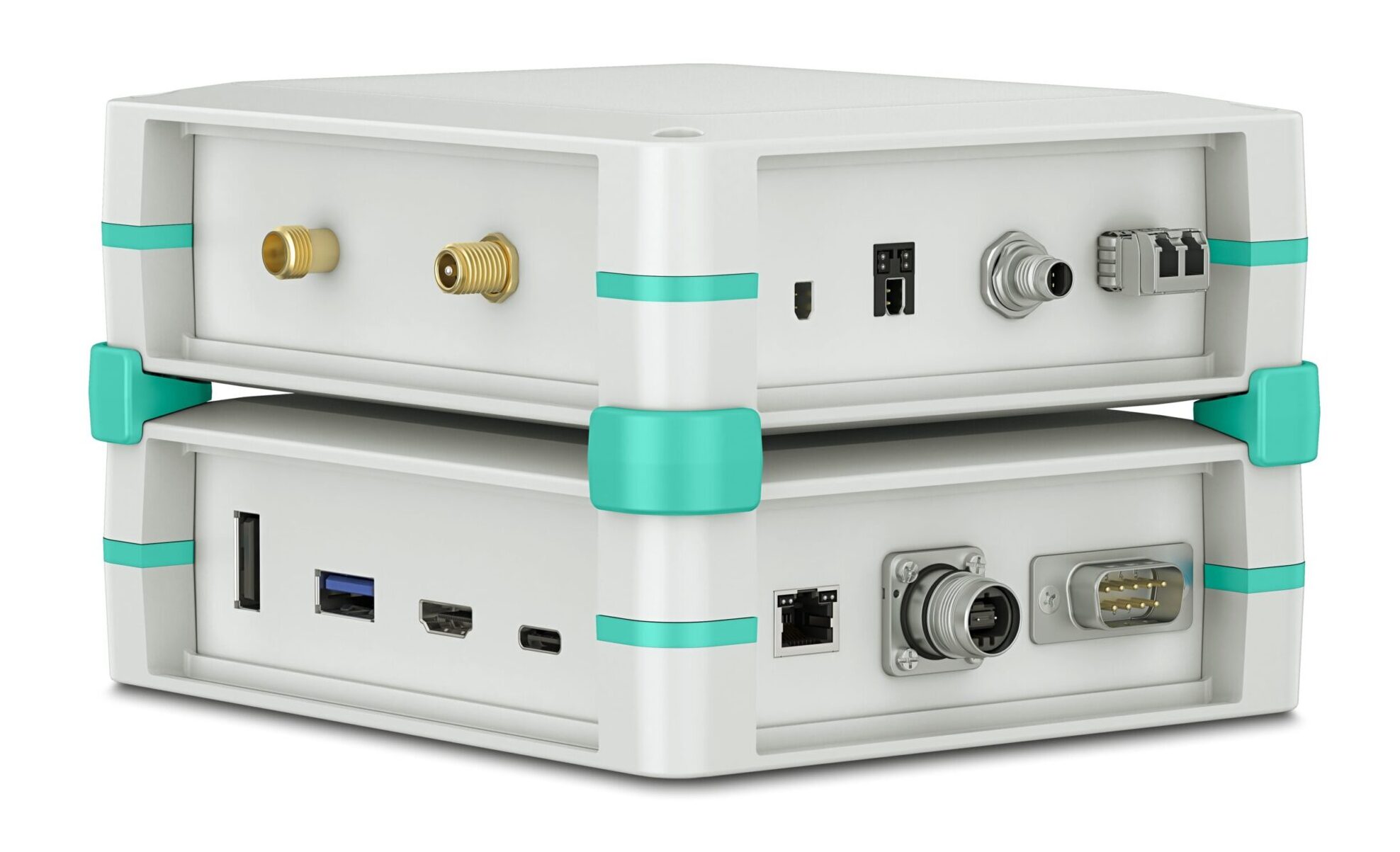
Phoenix Contact’s Universal Case System (UCS) enclosure with various panel-mounted interface connectors
Common industrial interfaces for data connectivity include connectors that enable Ethernet connectivity. Industrial RJ45 and M-type connectors (M12 X-Code) enable the Ethernet physical layer and other Internet Protocol (IP)-based communications. However, other connectivity solutions are specifically designed to meet the demands of complex automation processes while enabling longer reach (installation length) and high transmission speed. Solutions like single-pair Ethernet (SPE) and Advanced Physical Layer (APL) enable high-speed data transfers while extending the reach of Ethernet from 100 to 1,000 meters within half the footprint of RJ45 and M12 connectors.
Solutions designed for computer networking and peripherals are also making their way into industrial applications. More and more field devices now feature USB, HDMI, and SMA connectors for wired and wireless data transfer and diagnostics. Today’s industrial computers can have a wide range of standard interfaces, such as RJ45, M12, M8, USB, HDMI, SPE, terminal blocks, and fiber-optic connectors, to enhance compatibility with a wide variety of smart field devices.

Phoenix Contact offers a wide range of device connectivity solutions for different transmission speeds.
Transmission speed, transmission distance, panel spacing, communications protocol, and ingress protection rating can influence connector selection when designing a field device. Industrial RJ45 jacks offer increased mechanical strength and 360° shielding for improved performance and feature spring shielding for high shock and vibration resistance. Some of these connectors will support speeds up to 10 Gb/s over 100 meters for applications that require a standardized high-speed interface that is durable in industrial environments.
Another option for high-speed connectivity is a newly released line of SPE connectors with a miniaturized footprint half the size of a standard RJ45. These connectors enable Ethernet communications over a single pair of conductors, offer 360° shielding, and are optimized for industrial applications.
M-type connectors are also a viable solution for high-speed connectivity, especially in applications requiring a high degree of ingress protection, IP65 and above. Connectors like the M12 X-code and SPE M8 enable Ethernet connectivity for high-speed applications over a commonly used circular interface.
Device Cabling
Cabling is an important part of the device ecosystem, as it plays a vital role in the error-free transfer of the data collected from the field. The device interface and the cabling must mate reliably, yet still support the device’s data transmission requirements and withstand the application’s environmental conditions. In the case of existing infrastructure, device cabling solutions should also allow field termination. This task must be performed in the field quickly, using minimal tools. Factors for cabling selection are similar to those that influence interface connector selection, so manufacturers often recommend matching cabling with their interface connectors.
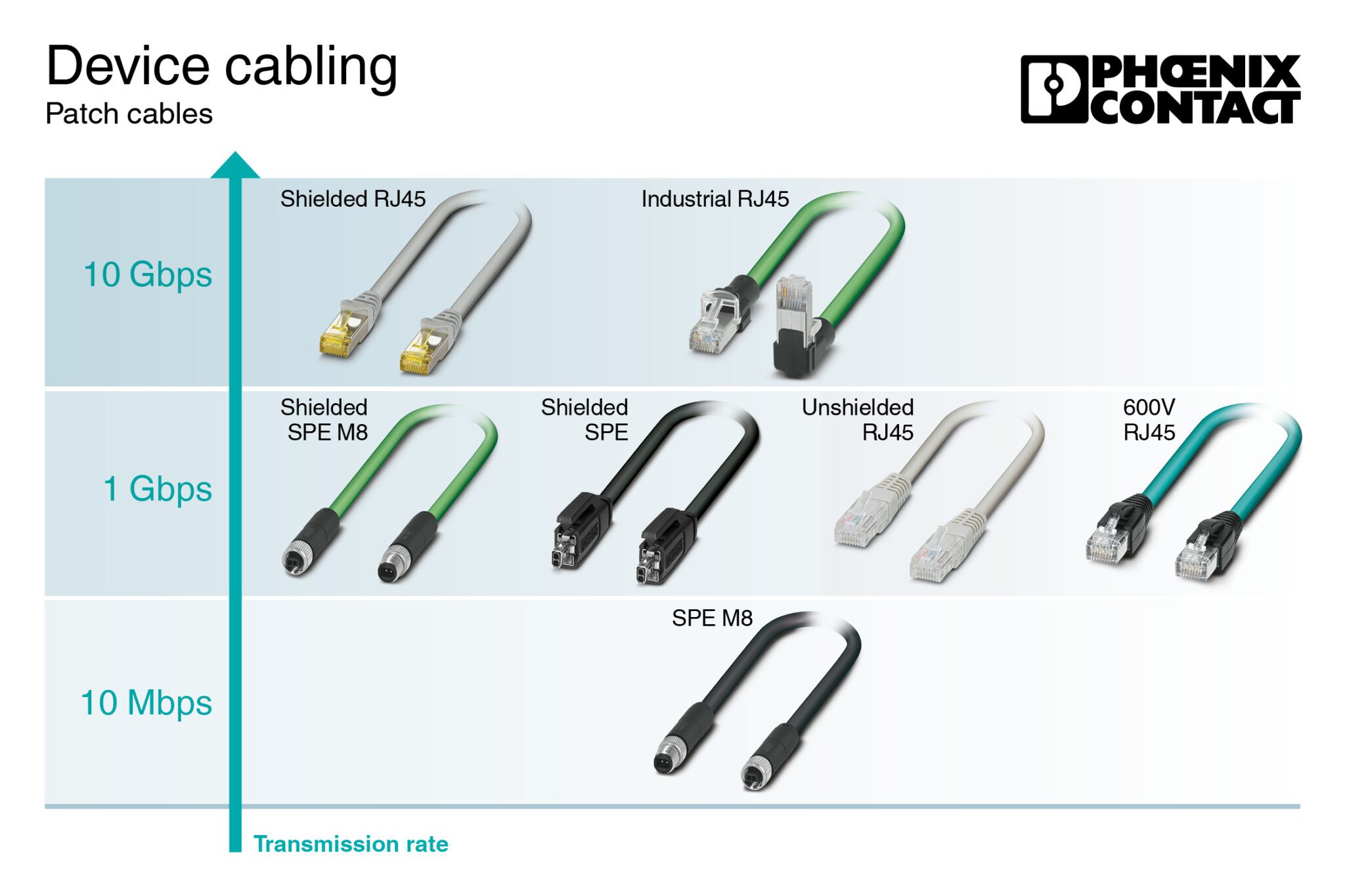
SPE and RJ45 patch cable solutions for various transmission speeds
Transmission speed, transmission distance, communication protocol, etc., can dictate which cabling is used for an application; however, other factors also apply to cabling. The installation often becomes a big factor, as some applications require field termination onto existing cabling infrastructure. Others, especially short cabling installations, can use preassembled cabling.
The cable jacket itself can also influence cabling selection in harsh environments. Certain areas may require Low Smoke Zero Halogen (LSZH) and High Flex cabling, as well as shielding and high-voltage cable jacket rating to protect the signal from noise.
Cabling solutions should be tested and validated for optimal performance and rated for different transmission speeds and with optional shielding to match various applications. Preassembled cabling for RJ45, SPE, USB, HDMI, COAX, as well as fiber optics pigtails and raw fiber, are all available. More specifically, RJ45 cabling can include unshielded, shielded, and industrial-graded cable assemblies that support transmission speeds ranging from 100 Mb/s to 10 Gb/s. SPE cabling also supports various speeds, with lower frequency (20 MHz) variants supporting 10 Mb/s and higher frequency variants (600 MHz) that support speeds up to 1 Gb/s over a single pair.
Other cabling options may include field-wireable solutions for RJ45, SPE , and circular-sealed connectors (M8, M12, etc.), with guaranteed optimal performance when used with their PCB-mount and panel-mount counterparts.
The intersection between industrial reliability and data transmission
Ruggedized high-speed connectivity solutions are a crucial part of the smart field device infrastructure. Industrial devices will continue to evolve to support higher data rates as the push for digitalization promises optimized production and minimal downtimes. Board-to-board and interface connectors and cable assemblies rated for harsh environments allow for the modernization of the field devices that support IIoT and Industry 4.0. Device manufacturers have the challenging task of designing the devices of the future while ensuring compatibility with existing infrastructure. To help them achieve this challenge, component manufacturers must support connectivity technologies and offer a wide range of solutions.
Visit Phoenix Contact to learn more about solutions for industrial environments.
Like this article? Check out our other articles on Manufacturing and High-Speed, our Industrial Market Page, and our 2022 Article Archive.
Subscribe to our weekly e-newsletters, follow us on LinkedIn, Twitter, and Facebook, and check out our eBook archives for more applicable, expert-informed connectivity content.
- The Future of Field Device Infrastructure - April 11, 2023
- Connect, Network, Evolve: The Intersection Between Reliability and High-Speed Industrial Communications - September 6, 2022
- The Case for Single-Pair Ethernet in Industrial Applications - August 10, 2021
